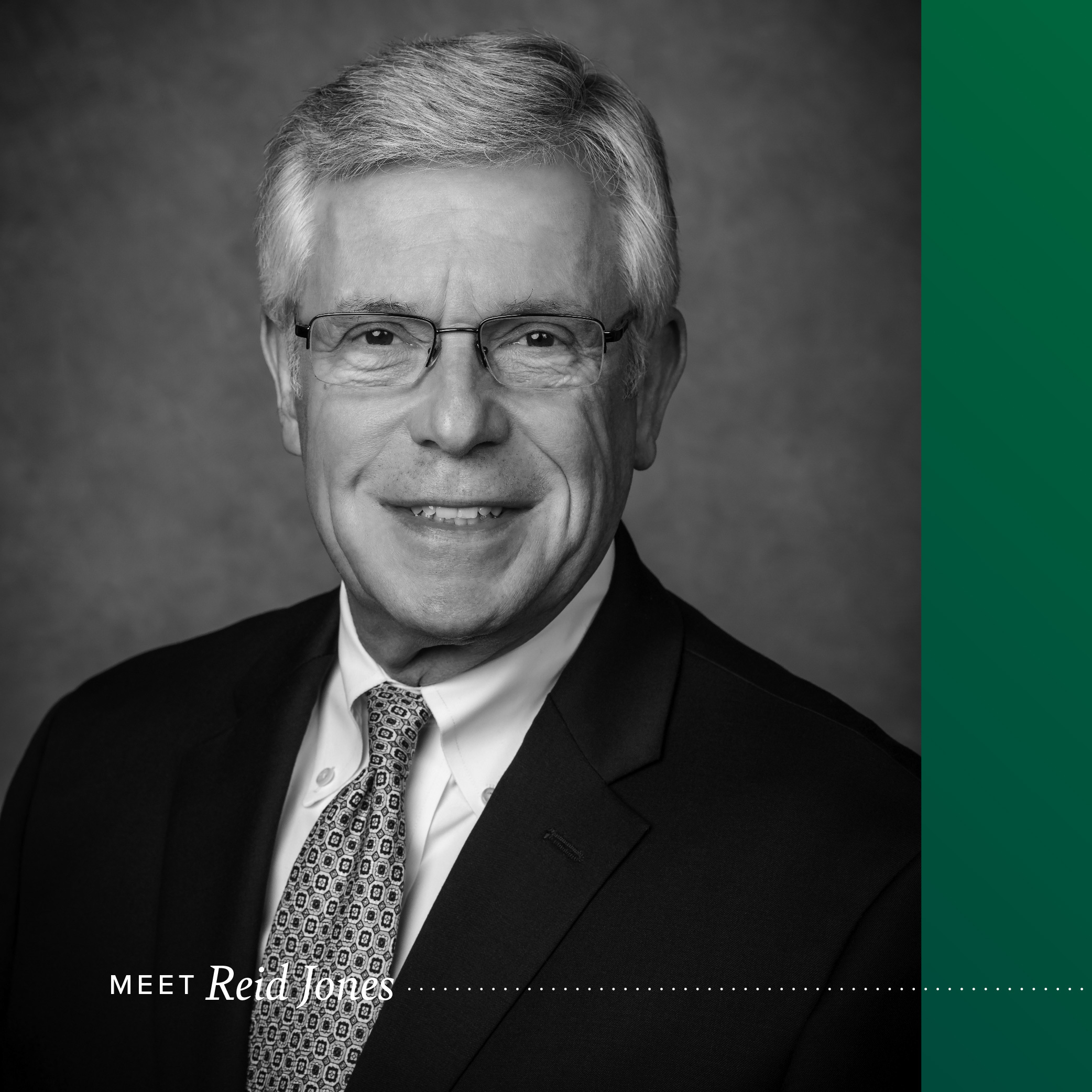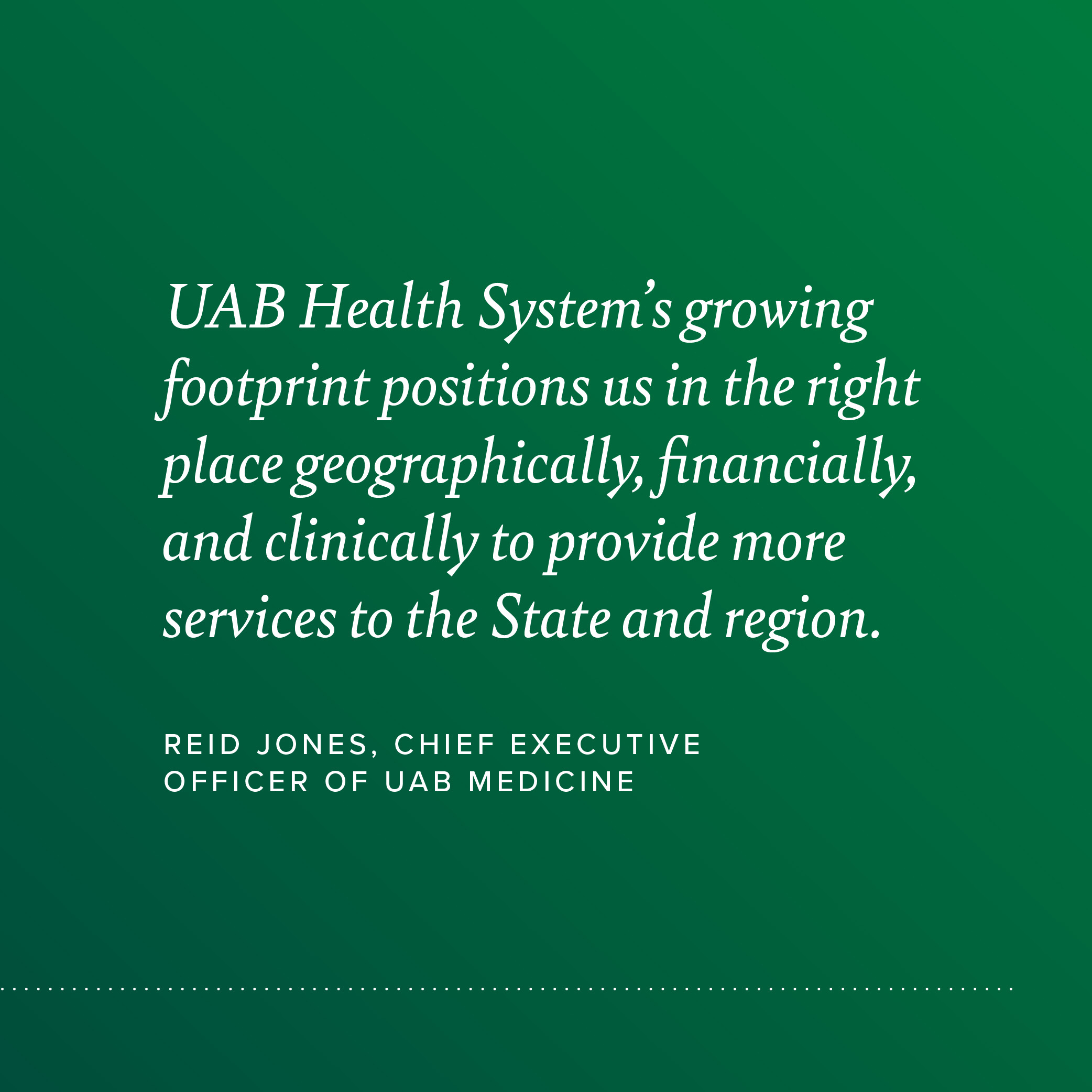 In the "Meet medicine leadership" series, key leaders who are critical to supporting Selwyn M. Vickers, M.D., FACS, in his transition to the role as dean of the Heersink School of Medicine, CEO of UAB Health System and CEO of the UAB/Ascension St. Vincent’s Alliance, are sharing their stories and vision for UAB.
In the "Meet medicine leadership" series, key leaders who are critical to supporting Selwyn M. Vickers, M.D., FACS, in his transition to the role as dean of the Heersink School of Medicine, CEO of UAB Health System and CEO of the UAB/Ascension St. Vincent’s Alliance, are sharing their stories and vision for UAB.
This week, the communications team sat down with Reid Jones to talk about his 30-year career at UAB, what it was like to work with UAB giants Arnold "Gil" Diethelm, M.D., and John Kirklin, M.D., and his vision as the UAB Health System moves forward.
Since 1991, Reid Jones, chief executive officer of UAB Medicine Enterprise, has served in multiple leadership positions across UAB, uniquely preparing him for his future role leading UAB Medicine.
Now, with Vickers’ transition to the dual Dean and CEO role, Reid Jones is excited to be a part of such a strong leadership team. “Dr. Vickers’ role is a much bigger responsibility now, but he has a supportive team to continue to move the organization forward. We have a great senior team,” he said.
The building blocks of a career in health care leadership
Reid Jones, who has been at the center of UAB’s health care administration and operations for over three decades, spent his first five career years at Blue Cross Blue Shield auditing hospitals. “Early on, I got to see how many hospitals functioned from the top down, which gave me a unique point of view.”
During that time, Medicare was reimbursing hospitals based on cost, and part of Reid’s role at Blue Cross was to help prepare the report which determined how much the hospital was paid. This, too, was experience that would prove to be very helpful throughout his career.
Known by leadership as humble and kind, Reid said that early role set him up nicely for what was to come next—a 12-year career at St. Vincent’s. His many roles at St. Vincent’s are experiences that have come full circle with the UAB/Ascension St. Vincent’s Alliance.
“I grew up professionally at St. Vincent's," he said. He began his career there as a financial analyst and, over a decade later, left St. Vincent’s as the vice president for Planning and Development. During his time there, his most prominent responsibilities included strategic planning, marketing, public relations, business development, real estate acquisition, hospital construction, physician recruitment, and managing physician practices.
Working with UAB giants in the 1980s
In 1991, Reid was approached by the late Arnold "Gil" Diethelm, M.D., former chair of the Department of Surgery, because his longtime executive administrator was retiring. “I was not unhappy at St. Vincent’s,” Reid said. “But, I appreciated that UAB presented a unique and significant opportunity. I was delighted to join this special place.”
Diethelm was, and still is, known across UAB for his vast impact on transplantation. Diethelm built a nationally recognized transplant program—the same one that recently published a study in the American Journal of Transplantation of researchers who successfully tested the first human preclinical model for transplanting genetically modified pig kidneys into humans.
But beyond his clinical work and patient care, Diethelm was outspoken about his diversity, equity, and inclusion values. He laid the foundations for the values we live today.
“In 1968, when Dr. John Kirklin recruited Dr. Diethelm, Birmingham was a much different place,” Reid recalled. “Regardless, Dr. Kirklin and Dr. Diethelm would have no part in discriminatory care. I saw their commitment firsthand, especially with Dr. Diethelm as he developed the kidney transplant program. Renal disease is very prevalent in the African American community. Diethelm acknowledged the need and took care of all patients.”
Reid said Diethelm was most concerned with taking care of patients and ensuring each patient had access to care, no matter their race or ability to pay.
For over eight years, Reid worked for Diethelm and spent a lot of time with both Diethelm and Kirklin. He said both men were “larger than life.”
 He said one notable moment during his time in the Department of Surgery was when they hired a young GI pancreatic surgeon, the first full-time Black/African American faculty member in the department, named Dr. Selwyn M. Vickers. “I remember that we all thought he was such a super guy.”
He said one notable moment during his time in the Department of Surgery was when they hired a young GI pancreatic surgeon, the first full-time Black/African American faculty member in the department, named Dr. Selwyn M. Vickers. “I remember that we all thought he was such a super guy.”
On his time in the Department of Surgery, he said, “As I look back, it’s quite a story to have worked with these medical giants.”
Consolidating business practices
During his time in Surgery, many departments had their own separate billing operations. “There were six or seven billing operations in place,” he explained. “A number of us recognized the inefficiencies.” At this point in his career, he pivoted away from the Department of Surgery and began consolidating all revenue cycle functions for the Practice Plan.
“I spent two years, before I left Surgery, working with a team to plan the consolidation. It was complex.” The project's main goal was to pull each disparate system together to create one unified system.
Thanks to a great team and support from leadership, “we transitioned the systems seamlessly," he said.
Subsequently we saw a substantial improvement in billing performance, and the metrics used to judge a revenue cycle all moved significantly.
At the forefront of UAB’s health care system
Around 2001, Reid took on the executive vice president role of the UA Health Services Foundation and stayed there for over 12 years. “I worked closely with chairs and administration across UAB, including UAHSF Presidents Dr. John Whitaker, Dr. Tony Bueschen, Dr. Sergio Stagno, Dr. Jim Bonner, and Dr. Ray Watts,” he said. “I got to know Dr. Watts very well and we are fortunate to have him as president of UAB.”
Around the same time Reid took on the executive vice president role, UAB Health System was expanded.
In 2013, Reid was named to a new chief operating officer position of UAB Medicine, where he continued to streamline ambulatory care efforts, enhanced operations, and aligned UAB Medicine to improve patient experience.
In 2020, Reid was asked to serve as CEO of UAB Medicine Enterprise, as former CEO Will Ferniany, Ph.D., shifted to focus on the UAB/Ascension St. Vincent’s Alliance. During Reid’s tenure in his COO and CEO positions, UAB Medicine's footprint has greatly expanded to include urgent care and primary care and specialty care clinics across the Birmingham metro area and cities such as Gardendale and Hoover.
Excitement for the future
Now, with CEO and Dean Vickers’ role transition, Reid said many pieces are coming together to continue to propel UAB Health System into national prominence.
“We are entering an era of significant new opportunity with the Alliance. We will continue to grow and expand our impact. UAB Health System’s growing footprint positions us in the right place geographically, financially, and clinically to provide more services to the State and region.”
On working with the Alliance as a former St. Vincent's staff member, he said, "It’s interesting and rewarding to me, personally, that 30 years after I left St. Vincent’s, we are now affiliating with them.”
Reid noted that the Alliance is still new but is already resulting in valuable collaborative efforts across the entities. He noted that it’s clear the Alliance formation is one of the most essential things our health system has done to position us for the future.
Out of the office: Hanging out with family
Outside of work, Reid said he enjoys golf and enjoys summer days at his cabin on Lake Logan Martin.
But most of his free time is spent with his family. He lights up when he mentions his four grandchildren—two girls and two boys. “My oldest granddaughter is about to graduate from high school,” he said. He smiled when he said she is considering UAB for college. “I have another granddaughter who is very much into dance, and two six-year-old twin grandsons who are quite a handful. I am fortunate that my grandchildren live in Birmingham, and I can spend time with them.
In good hands
"It is a privilege to serve as CEO of UAB Medicine," he said. "We are well-positioned for the future, and we have outstanding leaders who will continue to move UAB Medicine and UAB Health System forward to meet our ultimate goal of improving the health of our patients and more broadly, our fellow Alabamians.”